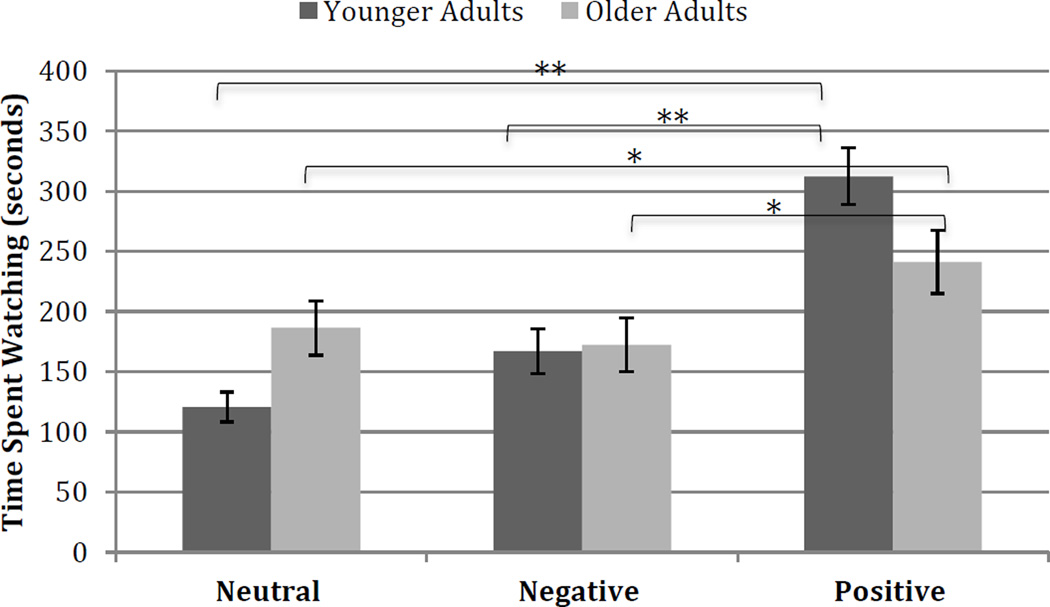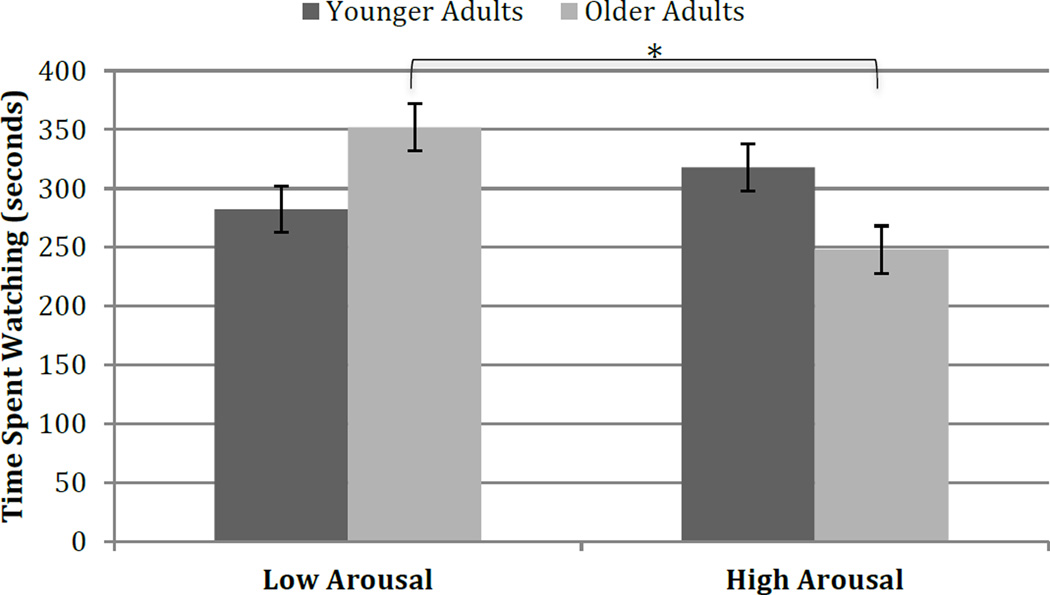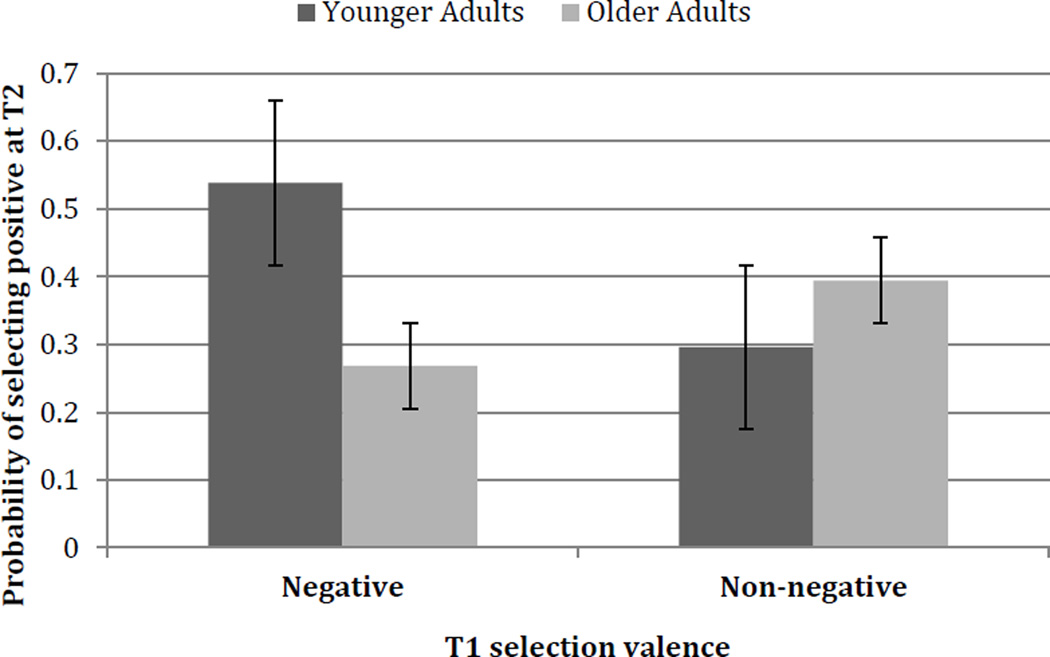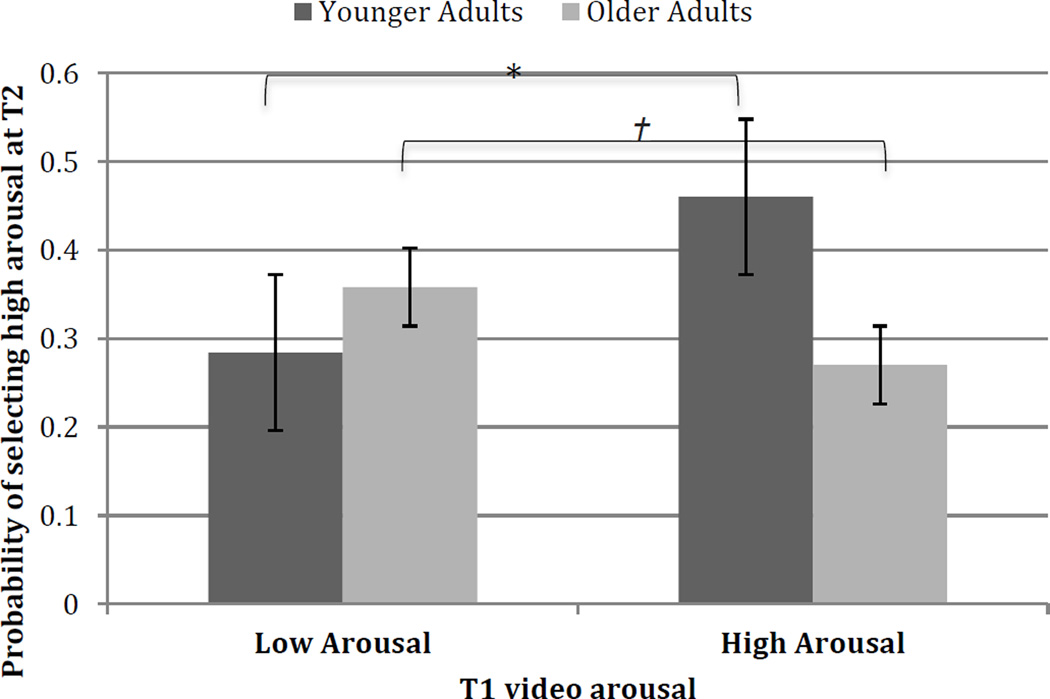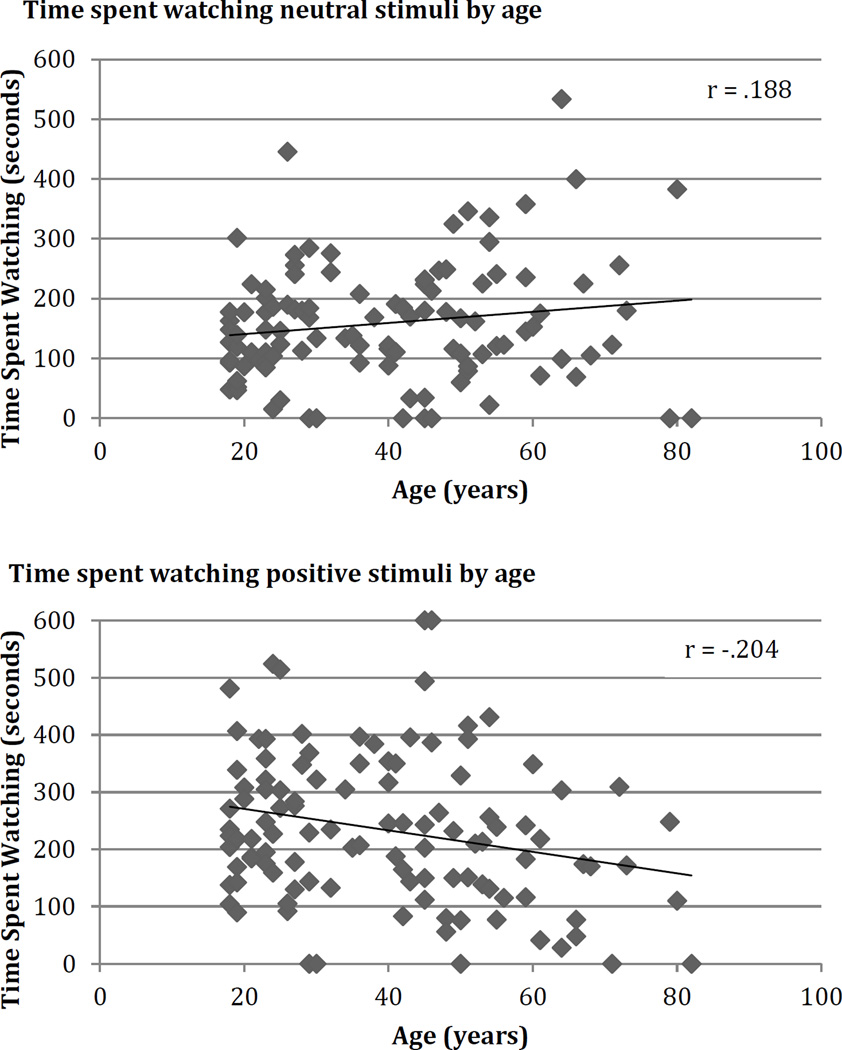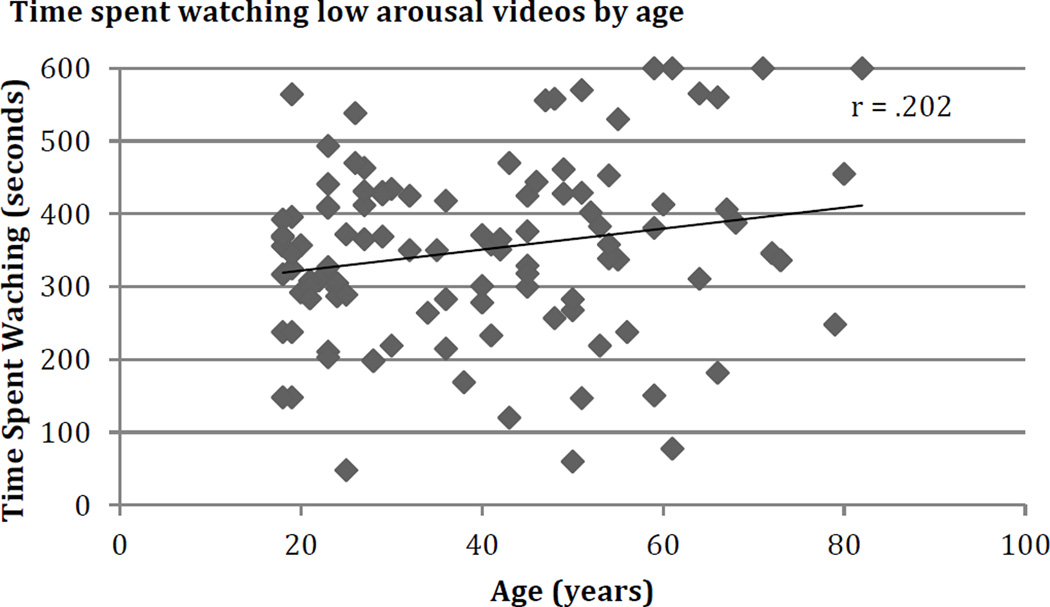Abstract
Older adults are theorized to benefit from proactive forms of emotion regulation that allow them to avoid negative stimuli (Charles, 2010). To test this, we examined choices as a form of emotion regulation. In two studies investigating age differences, participants selected affective stimuli using a cable television interface, while choices and mood were recorded. In lab-based Study 1, older adults spent more time watching neutral channels, but younger adults spent more time watching positive ones. Older adults also watched more low-arousal content, while younger adults watched more high-arousal content. Lagged analyses revealed that younger adults’ choices were directed toward increasing positive affect and arousal. Study 2 replicated these findings in a community-based adult lifespan sample at a local museum. These findings suggest that arousal plays an important role in motivating emotion regulation behavior in the context of selections, and this differs by age.
Keywords: emotion regulation, aging, situation selection, arousal, choice
Given the multitude of emotional stimuli in everyday life, one important way people can regulate their emotions is by selecting, avoiding or modifying situations according to their emotional goals (Gross & Thompson, 2007). Theoretically, researchers have suggested that as people get older they may be more likely to use forms of emotion regulation that limit or avoid engagement with negative emotional content; strategies that allow regulation before an emotion unfolds are thought to be increasingly effective with age (Charles, 2010; Urry & Gross, 2010). Rather than reducing or altering existing emotions, older adults may benefit more from choosing situations that facilitate positive emotional goals. However, empirical studies of these forms of emotion regulation are lacking. In two studies, we examined how people control the emotional content they engage with during an everyday situation – watching television. In this context, once a choice is made, various outcomes are possible: the channel’s content is emotionally gratifying or interesting and the viewer keeps watching, or the content is boring or upsetting and the viewer changes the channel. This possible range of behaviors illustrates how choosing and changing channels can reflect real-time emotion regulation; there may be age differences in how people behave in this context.
Emotion regulation across adulthood
As people age, they experience higher levels of emotional well-being; Socioemotional Selectivity Theory (SST) posits that this is because older adults place increased value on positive emotional goals (Carstensen, Isaacowitz & Charles, 1999). One way older adults may achieve these goals is by effectively regulating their emotions. The Strength and Vulnerability Integration framework (SAVI) applies SST to emotion regulation by outlining how age-related changes in resources may impact emotion regulation behavior. Specifically, SAVI posits that older adults shift toward strategies that allow them to regulate before a full-blown emotional response has unfolded, rather than strategies aimed at reducing existing negative emotions (Charles, 2010). For example, older adults shift their attention towards positive and away from negative emotional content (Reed, Chan & Mikels, 2014), which is associated with better emotional outcomes (see Isaacowitz, 2012 for a review).
SAVI theorizes that early forms of emotion regulation – such as shifting attention or selecting positive situations - are more effective for older adults because they rely on resources like knowledge and experience, which improve with age, rather than cognitive or physiological flexibility, which tend to decline. One conceptual advance of SAVI is considering how changes in physiological arousal may relate to emotion regulation. Older adults generally have blunted, but prolonged, reactivity during emotional experiences (Shiota & Neufeld, 2014). Choosing situations that align well with emotional goals - and avoiding ones that do not - may require fewer physiological resources than altering an existing emotional response, which is especially advantageous for older adults.
According to the process model of emotion regulation the earliest opportunity individuals have to regulate their affective states is at the level of the situation. While regulation of an existing emotion differs from making decisions about the emotional content one engages with these are both important ways people can influence emotional outcomes. People can select, avoid or modify situations in ways that align with their emotional goals and these choices have important implications for affective experience (Thompson & Gross, 2007; Livingstone & Isaacowitz, 2015).
However, in typical past studies, younger and older adults are presented with unavoidable emotion-eliciting stimuli determined by the researcher; the ways they can regulate their emotions are limited since they have no control over the stimuli they are presented with. Though selections of emotional situations are theoretically important for understanding emotion regulation in older age, empirical research about the types of emotional situations people choose, and how arousal may influence these choices, is sparse.
As a first step toward putting choice into studies of emotion regulation we developed an “affective environment” (AE) paradigm. In the AE, participants select from positive, negative and neutral articles, images and videos. Initial studies in the AE found no main effect of age on the valence of selected stimuli, suggesting that behavioral selections may not mirror age differences in patterns of cognitive processing (Rovenpor, Skogsberg & Isaacowitz, 2012; Isaacowitz et al., 2014).
A TV paradigm for studying emotion regulation
In the current studies we use an everyday activity – watching television - to test important theoretical questions about how people regulate their emotions in an ecologically valid context. The average American young adult spends over three hours a day watching television – with that number rising to seven after age 65 – suggesting that an increasing (and substantial) portion of people’s emotional lives may take place in front of the television with advancing age (Nielsen, 2015). The TV paradigm improves on the AE for testing potential age differences in emotional choices in a number of critical ways. First, the AE is an unfamiliar context with multiple stimuli presented across multiple modalities. Many choices presented simultaneously may be distracting and cognitively demanding (Iyengar & Lepper, 2000), especially for older adults. Positivity effects in attention and memory seem most pronounced in studies that minimize cognitive demands (Reed, Chan & Mikels, 2014), so sources of competing attention may be a limitation of the AE. In the TV paradigm, participants simply flip to another channel, minimizing cognitive demands and thus maximizing the possibility of uncovering any potential age-related positivity effects in selections.
We also use this paradigm to overcome an important conceptual limitation of prior research; namely, a focus only on the valence dimension of affect, while ignoring the role of arousal. Age-related positivity effects are typically attributed to older adults’ desire to increase positive emotions; however, stimuli comparisons are rarely matched for arousal (Carstensen et al., 1999; Reed et al., 2014). Age differences in the effect of stimulus arousal and changes in physiological function raise the possibility that positivity preferences are motivated by a desire for lower levels of arousal rather than exclusively by positivity. A recent experience sampling study found that older adults preferred low-arousal more than high-arousal positive emotions (Scheibe et al., 2013). While that study only examined positive emotions, it suggests that arousal may play a key role in emotional preferences particularly in older adulthood. Older adults also experience high-arousal stimuli as less pleasant regardless of their intended valence, though younger adults’ ratings do not show this pattern (Keil & Freund, 2009).
One important function of emotion regulation is to regulate physiological responses to be adaptive in the context (Thompson & Gross, 2007). Since physiological flexibility declines and reducing arousal responses becomes more challenging with age, it may be advantageous for older adults to regulate affect to maintain lower levels of arousal (Charles, 2010). Only one previous choice study has examined this valence-arousal interaction directly and provided initial evidence that arousal may be important for motivating selections (Sands & Isaacowitz, 2016). In the TV paradigm we systematically vary both valence and arousal to examine how each of these affective dimensions of stimuli motivates selections. Participants can rapidly acquire information about the stimuli through a TV-guide with channel names and video descriptions that convey information about valence and arousal. These studies allow us to address a missing link in emotional development research: proactively choosing the emotional content in ones’ environment is theorized to be a particularly effective way older adults regulate their emotions (e.g., Charles, 2010), but research about how this strategy is used in everyday life is lacking.
Hypotheses
SST posits that older adults will behave in ways that allow them to maximize positive affect and minimize negative affect (Carstensen et al., 1999). Our original AE hypotheses were derived from this perspective. While we did not find consistent support for positivity effects in those studies, the TV paradigm emulates an everyday context that minimizes cognitive demands to provide a situation that would maximize the ability to identify any potential positivity effects in selections of stimuli (Reed, Chan & Mikels, 2014). This positivity hypothesis predicts we will find age-related positivity effects in selections of affective stimuli; specifically, that older adults will avoid negative stimuli and select positive stimuli more than younger adults. However an alternative perspective, which we will refer to as the arousal hypothesis, is that arousal may turn out to be more important than valence. Positivity-based frameworks do not typically address the role of arousal; however, SAVI includes physiological function as an explanation for age-related changes in the strategies people use. The arousal perspective takes this one step further by proposing that changes in arousal preferences might actually be motivating age differences in selections of emotional content. In the case of the arousal hypothesis, we would hypothesize that older adults’ selections would reflect a goal of arousal regulation. Specifically, they would prefer low-arousal stimuli regardless of valence while younger adults would exhibit a preference for high-arousal stimuli. In either case, we hypothesize that valence of the selected videos would predict how positive or negative participants felt. Additionally, we predict that videos of the desired arousal state, which may differ by age, will be experienced as more pleasant.
Study 1
Method
Participants
Participants were 30 younger adults (Mage = 18.89, SDage = 1.37; 80% female) and 30 older adults (Mage = 72.61, SDage = 8.61; 51% female). The authors conducted a power analysis using G*Power 3.1.9.2 by estimating the expected effect size (η2 = .113) from a prior study examining age differences in selections (Sands & Isaacowitz, 2016; Faul, Erdfelder, Lang & Buchner, 2007). We determined that for a repeated-measures ANOVA with between and within-subjects factors a sample size of 28 subjects per age group would yield 80% power using α = .05. We tested 30 individuals in each age group because past studies had occasional data loss with older adults. Younger adult participants were recruited through the Northeastern University participant pool and compensated with course credit. Older adult participants were recruited from the greater Boston community and compensated $10 per hour. All older adults passed the Mini-Mental Status Exam (Newkirk et al., 2004). Younger adults were 56.7% Caucasian, 30% Asian, 6.7% African American and older adults were 90.3% Caucasian and 9.7% African American. Older adults reported higher levels of positive affect, t(58) = −3.09, p = .003, and lower levels of negative affect, t(58) = 2.24, p = .029 (PANAS; Watson et al., 1988). Age groups did not differ in self-reported health, t(59) = .05, p > .25
Materials
Video stimuli
Affective videos, approximately 3–4 minutes in length, were rated by an independent group of older and younger adults and did not differ on valence, arousal or relevance. These ratings were used to group stimuli into six different TV channels by valence and arousal (e.g., positive high, negative low, etc.; see Supplemental materials).
Apparatus
All video stimuli were shown on a Samsung flat-panel LCD monitor. We developed custom software to emulate a local cable providers’ TV interface, making the monitor indistinguishable from a television. Participants changed channels and rated their mood using a standard cable company remote that was programmed to communicate with our computers using a custom infrared receiver.
Mood ratings
Participants were instructed to rate how they felt while watching the video on a scale of 0 (extremely negative) to 100 (extremely positive). If participants watched a video for 8 seconds or more, it was considered a “selection” and they rated how they felt while watching that video when they changed the channel. Videos watched for less than 8 seconds were considered “skips” and mood ratings were not provided so participants could freely scroll through channels they did not want to select.
Procedure
After providing informed consent, participants completed a basic demographic questionnaire and a cognitive and affective questionnaire battery. Then they were told “you will watch videos on TV just like you would at home. The videos are arranged in six different channels. You can flip through these channels using the remote control any time you wish. You can change channels midway through a clip, skip over videos all together, or flip back and forth between two clips.” Next, participants were instructed about how to change channels and provide mood ratings with the remote and did a practice round with the researcher. Finally, they were reminded they could select whatever they wanted and the researcher left the testing room while participants freely selected from the channels for ten minutes.
Results
Selections
Neutral content is inherently low in arousal (Lang, Bradley & Cuthbert, 1997), so valence and arousal could not be fully crossed1. Therefore, the effects of valence and arousal on selections were considered separately. A repeated-measures analysis of variance (ANOVA) revealed a main effect of valence, F(2,58) = 13.02, p < .001, η2 = .18, with participants spending the most time watching positive videos and less time watching negative, t(59) = 3.59, p < .001 and neutral videos, t(59) = 4.33, p < .001 (see Figure 1). There was also a significant age by valence interaction, F(2, 58) = 3.42, p = .036, η2 = .06, with older adults spending more time watching neutral videos, t(58) = −2.56, p = .013 and younger adults spending more time watching positive videos, t(58) = 2.02, p = .048.
Figure 1.
Time spent watching by valence for younger and older adults. *p < .05, ** p < .01. Error bars represent standard error of the mean (SEM).
The main effect of arousal was not significant, F(1, 58) = 1.47, p = .230, η2 = .03, but there was an age by arousal interaction, F(1, 58) = 6.15, p = .016, η2 = .10, with older adults spending significantly more time watching low-arousal videos, t(29) = 2.56, p < .015 (see Figure 2).
Figure 2.
Time spent watching by arousal level for younger and older adults. * p < .05. Error bars represent SEM.
Mood
We conducted multilevel modeling (MLM) analyses using maximum likelihood estimation with HLM 7 Student software (Scientific Software International, 2004) to examine how various types of emotional content influenced mood. All predictors were categorical and therefore dummy-coded. We entered the valence or arousal of the channel selected (e.g. positive, negative, neutral OR high/low) at Level 1 and age group at Level 2 to predict mood. We ran this model with positive channel selections as the reference group (e.g. positive vs. non-positive selections) and with negative channel selections as the reference group (e.g. negative vs. non-negative selections). As hypothesized, negative channel selections were associated with worse moods than positive and neutral channel selections, γ = −24.62 (SE = 3.62), t(58) = −6.80, p <.001. Mood ratings in response to negative channels did not differ by age group, γ = −1.80 (SE = 4.92), t(58) = −0.37, p = .716. Positive channel selections were associated with better moods, γ = 21.66 (SE = 3.38), t(58) = 6.41, p <.001, and again mood ratings did not differ by age group, γ = 0.03 (SE = 4.94), t(58) = 4.94, p = .996. We also examined how the arousal level of selected channels predicted self-reported mood. There was a main effect of arousal on mood ratings, γ = −5.21 (SE = 2.16), t(455) = −2.42, p = .016, with low-arousal videos being rated as less pleasant than high-arousal videos, likely because all neutral videos were low in arousal.
Predicting choices
To examine selections as a continuous form of emotion regulation, we used lagged MLM to explore patterns of selections likely to up-regulate positive emotions and down-regulate arousal (e.g., negative to positive, high-arousal to low-arousal)2. In these models, the valence of video selected at T1 was used to predict the valence of the video selected at T2 (T2 predicted T3 and so on). Video valence (or arousal) was entered at Level 1 and age group was entered at Level 2. Since predictors were categorical they were dummy coded and entered uncentered; outcomes were also categorical so we used a Bernoulli outcome distribution. First, we examined if selecting a negative video predicted if the next selection would be positive. Negative stimuli predicted that the next selection was more likely to be positive, γ = 1.02 (SE = .48), t(912) = 2.14, p < .033. There was an age by valence interaction, γ = −1.59 (SE = 0.58), t(912) = −2.72, p < .007. Older adults were less likely to follow a negative selection with a positive selection, x2 = 5.25, p < .02 (see Figure 4). We also conducted a similar analysis to examine if the arousal level of a selection predicted the arousal level of the next video participants selected. There was a main effect of video arousal on the arousal of the next video selected, γ = 0.69 (SE= 0.27), t(58) = 2.56, p = .01. There was also an age by arousal interaction, γ = −1.28 (SE = 0.41), t(58) = −3.12, p < .003. If watching a high-arousal video, younger adults are more likely than older adults to select another high-arousal video as their next selection, x2 = 9.86, p = .002 (see Figure 5).
Figure 4.
Probability of the next video selection being positive after watching a negative or non-negative video by age group. Error bars represent SEM.
Figure 5.
Probability of the next selection being high-arousal after watching a low or high-arousal video by age group. *p < .05, † p < .10. Error bars represent SEM.
Discussion
In this study we used a novel approach to examine how younger and older adults use TV selections to regulate their emotions. Although the positivity hypothesis would predict increased engagement with positive emotional content in older age, we found that younger adults spent more time viewing positive stimuli than older adults. Younger adults also were more likely to make selections consistent with a goal of increasing arousal, while older adults preferred low-arousal content. This pattern of findings is consistent with an arousal hypothesis and suggests that age differences in arousal preferences predict selection behaviors, even more so than valence preferences.
Study 2
In Study 2, we aimed to replicate the lab findings in a community setting; this also allowed us to expand our sample from an extreme age design to include individuals across the full adult lifespan (Freund & Isaacowitz, 2014).
Method
Participants
This research was conducted in Living Laboratory® at the Museum of Science Boston. We used G*Power to compute post-hoc power for the valence and arousal selection analyses conducted in Study 1 and found that we had 85% statistical power at α = .05 (Faul et al., 2007). We then used the smaller effect size from Study 1 to estimate necessary sample size for a regression analysis with two predictors; this indicated the need for a minimum of 84 subjects for 95% power. However, our final sample is larger because we expected greater variance in the community sample from the Museum and we agreed to conduct this research study there for two full semesters. Our final sample included 110 individuals from 18–82 years old (Mage = 39.43, SDage = 16.83) recruited to complete the study while visiting the Museum of Science. Fifteen participants were excluded because they did not complete the study or did not understand the instructions. Participants were 56.8% female; 85.6% Caucasian, 8.5% Asian; 95% reported “good” or better physical health.
Materials
The materials used in this study were identical to Study 1. Participants did not fill out the battery of cognitive/affective questionnaires due to time constraints at the Museum.
Method
The Living Laboratory® is set up as an exhibit in the Hall of Human Life at the Museum of Science Boston. Participants were either approached by researchers while exploring the exhibit or approached and were invited to participate in a study about emotion. All other instructions were identical to Study 1.
Results
Selections
As there were multiple observations for each individual in this continuous-age sample, we used MLM for all analyses because it allowed us to separately model variance within and between people and to use age as a continuous variable (see Supplementary materials for full models). Video valence and arousal were dummy-coded and entered as uncentered Level 1 predictors. Age (in years) was grand-mean centered and entered as a Level 2 predictor.
First, we examined how much time participants spent watching various types of stimuli. Participants spent more time watching positive, γ = 61.83 (SE = 18.73), t(102) = 2.37, p < .001, and negative videos, γ = 42.80 (SE = 18.03), t(102) = 2.37, p = .02, than neutral videos. There was also an effect of age. The older that the participants were, the more time they spent watching neutral videos, γ = 1.55 (SE = .63), t(86) = 2.14, p = .016, and less time they spent watching positive videos, γ = −3.50 (SE = 1.11), t(102) = −3.16, p = .002 (see Figure 6).
Figure 6.
Scatterplots of time spent watching neutral (top) and positive (bottom) videos by age. For ease of interpretation the trendlines and R2 are for linear regressions.
There was a main effect of arousal with participants spending more time watching low-arousal videos than high-arousal videos, γ = 350.14 (SE = 11.65), t(208) = 30.06, p < .001. There was also an age by arousal interaction with participants spending more time watching low-arousal videos if they were older, γ = 1.44 (SE = .73), t(208) = 1.98, p = .049.
We examined a valence by arousal by age interaction for positive and negative videos (because they had both high and low arousal levels) and found that the older participants were the less time they spent watching high-arousal positive videos, γ = −2.08 (SE = .87), t(108) = 3.44, p = .019.
Mood
There was a main effect of valence on mood ratings, with positive videos being rated as more pleasant than neutral, γ = 7.31 (SE = 3.58), t(177) = 2.04, p = .04 and negative videos being rated as more unpleasant than neutral, γ = −17.20 (SE = 4.16), t(102) = −4.12, p < .001. There was a main effect of video arousal on mood as well with low-arousal videos being rated as more pleasant, γ = 59.08 (SE = 3.60), t(95) = 16.41, p < .001. There was also an effect of age; as age increased, ratings of low-arousal videos became more positive, γ = 0.23 (SE = .09), t(95) = 2.45, p = .02.
Patterns of selections
As in Study 1, we examined if the video participants selected at T1 would predict selections at T2. We found that watching a negative video predicted that the next selection was more likely to be positive across age groups, γ = −0.46 (SE = .16), t(108) = −2.89, p = .005. There was also an age by valence interaction; the older participants were the less likely they were to follow a negative selection with a positive selection, γ = −0.02 (SE = .01), t(108) = −2.89, p = .027. We also examined how the arousal level of the current video influenced the arousal level of the next selection. We found that after selecting a high-arousal video participants were more likely to select another high-arousal video, γ = 0.39 (SE = .17), t(108) = 2.26, p < .026.
Discussion
We replicated the pattern of findings from Study 1 in an adult lifespan community sample. Older participants made choices that were consistent with a goal of maintaining low levels of arousal and did not express a greater preference for positivity than younger adults. Overall, these age differences in selections again provide support for the arousal hypothesis.
General Discussion
Selecting situations that align with emotional goals is thought to be a particularly effective way for older adults to attain high levels of emotional well-being (Charles, 2010). However, this dynamic form of emotion regulation is difficult to capture with traditional laboratory paradigms where participants are unable to control the emotional content they engage with. Here we studied selections as a form of emotion regulation in an everyday, familiar context. Using a TV paradigm, we examined age differences in selections: We compared a commonly-accepted positivity hypothesis to an alternative arousal hypothesis by examining if selections of affective material differ based on arousal, in addition to valence, across age groups.
The positivity hypothesis, derived from SST, predicted that older adults would avoid negative and instead select positive stimuli, in order to maximize positive emotions. Although we found clear age difference in valence preferences, the pattern of age differences in selections is not entirely consistent with SST. Participants across age groups spent the most time watching positive videos but younger adults actually spent more time watching positive videos than older adults. Older adults spent more time watching neutral videos than younger adults. Interestingly, there was no age difference in the time spent engaging with negative content. Additionally, younger adults actually showed a pattern of selections more consistent with increasing positivity than older adults (e.g., changing from negative to positive).
Younger adults showed a clear preference for high-arousal stimuli, while older adults spent more time watching low-arousal videos. Since neutral content is inherently low in arousal, the age differences in valence may have been motivated by age-differential arousal preferences. Younger adults were also more likely to follow high-arousal selections with another high-arousal choice, a pattern that suggests they were motivated to maintain higher arousal states. Older adults, however, were more likely to select a low-arousal stimulus after selecting a high-arousal video, a pattern that suggests a goal of down-regulating arousal.
Theoretically, these findings have important implications for understanding socioemotional development. SST, and related models, offer motivational explanations for increased positivity in older age that are based on enhanced engagement with positive emotional goals. Recently, the SAVI framework has incorporated age-related changes in physiological arousal when theorizing about the strategies older adults might use to maximize positive affect. However, our findings suggest that changes in arousal preferences may offer an explanation not only for how people regulate (e.g. which strategies they use) but also for why they regulate their emotions. Rather than solely a goal of increased positivity, older adults seem to experience changes in preferences for arousal states, which may be caused by underlying biological changes that relate to changes in emotion regulation behavior. Positive stimuli are typically lower in arousal than negative, which may contribute to this preference (Keil & Freund, 2008; Lang, Bradley & Cuthebert, 2007). In addition, age-related positivity effects are also contingent on younger adults preferentially engaging with negative content – a behavior they did not exhibit when they were able to control the situation.
Understanding age differences in emotional goals is important for interpreting the effectiveness of any form of emotion regulation. In this study emotional experience was closely related to the content participants selected (with negative choices leading to worse moods and positive choices to better moods regardless of age). Although older adults did not feel more positive after watching a neutral video than younger adults did, it may align better with their preferred affective state, particularly in terms of arousal. Recent work has also suggested this pattern of age differences in ideal affect; older adults prefer low-arousal, as opposed to high-arousal, positive emotions in daily life (Scheibe et al., 2013). Older adults are also more likely to want to maintain their levels of positive affect, while younger adults are more likely to desire to increase them (Riediger, 2009).
Selections differ in important ways from regulation of existing emotional states. Older adults benefit less from some forms of emotion regulation, such as detached reappraisal, that are employed during an emotional experience (e.g. Shiota & Levenson, 2009) yet they report higher levels of emotional well-being than younger adults. This discrepancy between strategy effectiveness and real life outcomes may be because older adults are effective at regulating their emotions by making choices about their emotional environment that align well with how they want to feel.
As neutral stimuli are low in arousal, we could not fully cross valence and arousal; however, this allowed the high-arousal stimuli to be matched for arousal ratings across valence. Even with this limitation it is evident that there are age differences in arousal preferences. Future studies should also account for the participant’s level of arousal to make claims about the effectiveness of these forms of emotion regulation for modulating arousal levels. Additionally, including a larger range of content and examining selections in other meaningful or relevant contexts would be beneficial for understanding emotional selections in everyday life throughout the lifespan.
We conclude that older adults’ preferences for low-arousal may be even stronger than their preference for “positivity” in everyday, familiar contexts. While studies of aging and emotion-relevant information processing often collapse across valence categories that differ in arousal (e.g., negative and neutral) our findings highlight the importance of considering valence and arousal, both of which are likely to motivate behavior, albeit differentially by age.
Supplementary Material
Figure 7.
Scatterplot of time spent watching low-arousal videos by age with the linear trendline.
Acknowledgments
This work was supported in part by NIA grant R01AG048731 to the last author, and by the Dr. Jean C. Nichols scholarship for undergraduate research in Living Laboratory at the Museum of Science, Boston.
Footnotes
Additional analyses were conducted using only positive and negative selections (which had low and high arousal content) to examine the valence by arousal interaction and are included in the supplementary materials.
We also coded participants’ self-reported explanations of why they changed the channel (see supplementary materials).
Contributor Information
Molly Sands, Lifespan Emotional Development Laboratory at Northeastern University.
Adam Garbacz, Lifespan Emotional Development Laboratory and received his B.A. in Psychology at Brandeis University.
Derek M. Isaacowitz, Psychology at Northeastern University and the Director of the Lifespan Emotional Development Laboratory.
References
- Carstensen LL, Isaacowitz DM, Charles ST. Taking time seriously: A theory of socioemotional selectivity. American Psychologist. 1999;54(3):165–181. doi: 10.1037//0003-066x.54.3.165. http://dx.doi.org/10.1037/0003-066X.54.3.165. [DOI] [PubMed] [Google Scholar]
- Charles ST. Strength and vulnerability integration: A model of emotional well-being across adulthood. Psychological Bulletin. 2010;136(6):1068. doi: 10.1037/a0021232. [DOI] [PMC free article] [PubMed] [Google Scholar]
- Charles ST, Mather M, Carstensen LL. Aging and emotional memory: The forgettable nature of negative images for older adults. Journal of Experimental Psychology: General. 2003;132(2):310–324. doi: 10.1037/0096-3445.132.2.310. http://dx.doi.org/10.1037/0096-3445.132.2.310. [DOI] [PubMed] [Google Scholar]
- Faul F, Erdfelder E, Lang A-G, Buchner A. G*Power 3: A flexible statistical power analysis program for the social, behavioral, and biomedical sciences. Behavior Research Methods. 2007;39:175–191. doi: 10.3758/bf03193146. [DOI] [PubMed] [Google Scholar]
- Freund AM, Isaacowitz DM. Beyond age comparisons: A plea for the use of a modified Brunswikian approach to experimental designs in the study of adult development and aging. Human Development. 2014;56(6):351–371. [Google Scholar]
- Gross J, Thompson R. In: Handbook of Emotion Regulation. Gross J, editor. New York, NY: The Guilford Press; 2007. [Google Scholar]
- Hess TM, Germain CM, Swaim EL, Osowski NL. Aging and selective engagement: The moderating impact of motivation on older adults’ resource utilization. The Journals of Gerontology Series B. Psychological Sciences and Social Sciences. 2009;64(4):447–456. doi: 10.1093/geronb/gbp020. [DOI] [PMC free article] [PubMed] [Google Scholar]
- Isaacowitz DM. Mood regulation in real time age differences in the role of looking. Current Directions in Psychological Science. 2012;21(4):237–242. doi: 10.1177/0963721412448651. [DOI] [PMC free article] [PubMed] [Google Scholar]
- Isaacowitz DM, Livingstone KM, Harris JA, Marcotte S. Mobile eye tracking reveals little evidence for age differences in attentional selection for mood regulation. Emotion. 2014;15(2):151–161. doi: 10.1037/emo0000037. http://dx.doi.org/10.1037/emo0000037. [DOI] [PMC free article] [PubMed] [Google Scholar]
- Iyengar SS, Lepper MR. When choice is demotivating: Can one desire too much of a good thing? Journal of Personality and Social Psychology. 2000;79(6):995–1006. doi: 10.1037//0022-3514.79.6.995. http://dx.doi.org/10.1037/0022-3514.79.6.995. [DOI] [PubMed] [Google Scholar]
- Keil A, Freund AM. Changes in the sensitivity to appetitive and aversive arousal across adulthood. Psychology and aging. 2009;24(3):668–680. doi: 10.1037/a0016969. [DOI] [PubMed] [Google Scholar]
- Lang PJ, Bradley MM, Cuthbert BN. International affective picture system (IAPS): Technical manual and affective ratings. NIMH Center for the Study of Emotion and Attention. 1997:39–58. [Google Scholar]
- Mather M, Carstensen LL. Aging and motivated cognition: The positivity effect in attention and memory. Trends in Cognitive Sciences. 2005;9(10):496–502. doi: 10.1016/j.tics.2005.08.005. [DOI] [PubMed] [Google Scholar]
- Newkirk LA, Kim JM, Thompson JM, Tinklenberg JR, Yesavage JA, Taylor JL. Validation of a 26-point telephone version of the Mini-Mental State Examination. Journal of Geriatric Psychiatry and Neurology. 2004;17(2):81–87. doi: 10.1177/0891988704264534. [DOI] [PubMed] [Google Scholar]
- Rovenpor DR, Skogsberg NJ, Isaacowitz DM. The choices we make: An examination of situation selection in younger and older adults. Psychology and Aging. 2013;28(2):365. doi: 10.1037/a0030450. [DOI] [PMC free article] [PubMed] [Google Scholar]
- Reed AE, Chan L, Mikels JA. Meta-analysis of the age-related positivity effect: Age differences in preferences for positive over negative information. Psychology and Aging. 2014;29(1):1–15. doi: 10.1037/a0035194. http://dx.doi.org/10.1037/a0035194. [DOI] [PubMed] [Google Scholar]
- Riediger M, Schmiedek F, Wagner GG, Lindenberger U. Seeking pleasure and seeking pain: Differences in prohedonic and contra-hedonic motivation from adolescence to old age. Psychological Science. 2009;20(12):1529–1535. doi: 10.1111/j.1467-9280.2009.02473.x. [DOI] [PubMed] [Google Scholar]
- Sands M, Isaacowitz DM. Situation selection across adulthood: the role of arousal. Cognition and Emotion. 2016:1–8. doi: 10.1080/02699931.2016.1152954. [DOI] [PubMed] [Google Scholar]
- Scheibe S, English T, Tsai JL, Carstensen LL. Striving to feel good: Ideal affect, actual affect, and their correspondence across adulthood. Psychology and Aging. 2013;28(1):160– 171. doi: 10.1037/a0030561. [DOI] [PMC free article] [PubMed] [Google Scholar]
- Shiota MN, Neufeld SL. My Heart Will Go On: Aging and Autonomic Nervous System Responding in Emotion. The Oxford Handbook of Emotion, Social Cognition, and Problem Solving in Adulthood. 2014:225–235. [Google Scholar]
- Urry HL, Gross JJ. Emotion regulation in older age. Current Directions in Psychological Science. 2010;19(6):352–357. [Google Scholar]
- Watson D, Clark LA, Tellegen A. Development and validation of brief measures of positive and negative affect: The PANAS scales. Journal of Personality and Social Psychology. 1988;54(6):1063–1070. doi: 10.1037//0022-3514.54.6.1063. http://dx.doi.org/10.1037/0022-3514.54.6.1063. [DOI] [PubMed] [Google Scholar]
- Wurm LH, Labouvie-Vief G, Aycock J, Rebucal KA, Koch HE. Performance in auditory and visual emotional stroop tasks: a comparison of older and younger adults. Psychology and Aging. 2004;19(3):523. doi: 10.1037/0882-7974.19.3.523. http://dx.doi.org/10.1037/0882-7974.19.3.523. [DOI] [PubMed] [Google Scholar]
Associated Data
This section collects any data citations, data availability statements, or supplementary materials included in this article.



